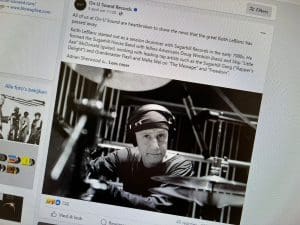A quick history of smoking in music
Smoking and music go way back. From smoke seductively coiling around the singer in a jazz club to rebellious teenage rock stars with a cigarette hanging from their lips – smoking is part of the iconography of popular music.
Cigarettes feature in song lyrics, are seen hanging out of musicians mouth on stage and off-stage and until the smoking-ban in recent years, smoke filled the air in clubs and music venues.
Today, smoking is even being deleted from history (as much as it can be). When a poster of the Beatles’ Abbey Road album cover was released in the US, Paul McCartney’s cigarette was simply airbrushed out. The cigarette was airbrushed out because music in all its forms as always influenced people from any age, in all times.
Song lyrics often simply reflect society and talk about situations that listeners find familiar, so naturally everyday habits such as smoking come up.
After cigarettes became known to be bad for health, smoking was then seen as rebellious. Cigarettes then featured in song lyrics often to depict an area of society not necessarily experienced by the listener, but seen as ‘cool’ – the life of a rock star, criminal or gangster. In particular, rock and pop music has often contained references which have outraged each generation’s parents and this includes references to cigarettes.
Probably the most powerful influential effect music has is on teenagers. Teenagers gravitate towards music to sooth their angst ridden teenage years and to vent their frustrations. Music effects their vision of the world, themselves and their friends.
It is easy to see the drop in popularity of smoking in music over the years by looking at just a small selection of songs:
Two Cigarettes in the Dark, Bing Crosby, 1934
This song came at a time when cigarettes were advertised as healthy and as a cure for certain ailments. Back in the 1920s, 30s, 40s and 50s musicians didn’t know the risks.
Crosby is credited for inspiring the singers that followed him such as Frank Sinatra and Dean Martin, creating and moulding a culture. This culture heavily included cigarettes, not only in the lyrics, but also by the singer smoking on stage.
Three Cigarettes in an Ashtray, Patsy Cline, 1957
The song lyrics here uses smoking to denote romance and then heart-break, with ‘two cigarettes in an ashtray/ my love and I, in a small cafe/ then a stranger came alone / and everything went wrong/ now there’s three cigarettes in the ashtray’. It then concludes: ‘I watched her take him from me/ and his love is no longer my own / now they are gone/ and I sit alone / and watch one cigarette burn away’.
Cigarettes and Coffee, Otis Redding, 1966
In this love song, the lyrics put cigarettes and coffee together as they are part of the singers routine with their lover. In a time when cigarettes were still popular the lyrics are simply reflecting a shared relaxation between a couple.
Rock and Roll Suicide, David Bowie, 1972
In his younger years, David Bowie was often seen smoking. Bowie admitted in an interview he gave about smoking in 1997 that it was a ‘rite of passage’ when he was young and he admitted that he would sing better if he didn’t smoke. Bowie also said that he used cigarettes like a prop on stage in the past, lighting them with a match for dramatic effect. At the time of the interview he admitted that cigarettes were now simply an addiction, he would no longer even think to use them as props.
In this song’s infamous opening lines ‘Time takes a cigarette, puts it in your mouth’ Bowie was saying that ‘life is a cigarette, smoke it in a hurry or savour it’.
Nicotine Stain, Siouxsie and the Banshees, 1978
Now that smoking is known to be bad for your health, the lyrics begin to reflect this: ‘When smoke gets in my brain/ I can’t resist it’ talking about the addiction, and then – ‘I can feel my lungs collapse’…and ‘wallow in that ash bath/ soaking up the fumes’.
Sugar Mountain, Neil Young, 1979
In this song, Young describes a young person’s ‘first cigarette’ hiding beneath the stairs at a fair – and highlights that cigarettes are often used when people want to separate themselves away from a crowd and from social pressures.
Cigarettes and Alcohol, Oasis, 1994
Called ‘one of the greatest social statements of the past 25 years’ by Alan McGee the man who discovered the band, the lyrics in this song point at cigarettes and alcohol as a way of coping with the banality of work class life in the 1990s. With lines such as ‘is it worth the aggravation to find yourself a job when there’s nothing worth working for?’ the attitude to cigarettes also gives a ‘who cares?’ attitude to health. Teenagers in the 1990s were drawn to the rebellious song title and lyrics.
Guns and Cigarettes, Atmosphere, 2001
The claim that Atmosphere will be bigger and better than two of the most dangerous industries in the world is a big and deliberate statement designed to shock (or maybe simply laugh at the audacity) – but whatever the reaction, it was designed to get people to notice – and sell.
Twenty Seven, Passenger, 2004
In recent years, smoking has slowly become out of fashion. In fact, even back in 2004 Passenger sings against smoking in ‘Twenty Seven’ saying he wishes he’d never smoked a cigarette: ‘My lungs are turning black…been a Lucky Strike’s fool since I was at school’.
Today, with vaping on the rise as a way of giving up smoking, music continues to reflect society with vaping is now featuring in song lyrics, with rappers talking about ‘inhaling the vapes’ and ‘hitting the vapes’. It seems like vaping is successful in getting smokers to give up smoking and vaping is also seen as cool in popular music.
However, ultimately, the role of music is not to promote pro-health ideas, but to reflect society’s imagination and storytelling. Music is an art. Just like a filmmaker or author – just because a musician sings about cigarettes does not mean that they endorse them.
Since you’re here …
… we have a small favour to ask. More people are reading Side-Line Magazine than ever but advertising revenues across the media are falling fast. Unlike many news organisations, we haven’t put up a paywall – we want to keep our journalism as open as we can - and we refuse to add annoying advertising. So you can see why we need to ask for your help.
Side-Line’s independent journalism takes a lot of time, money and hard work to produce. But we do it because we want to push the artists we like and who are equally fighting to survive.
If everyone who reads our reporting, who likes it, helps fund it, our future would be much more secure. For as little as 5 US$, you can support Side-Line Magazine – and it only takes a minute. Thank you.
The donations are safely powered by Paypal.










